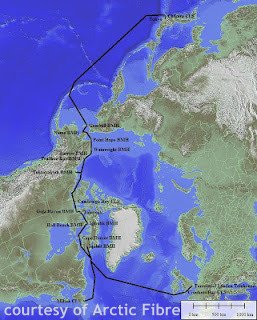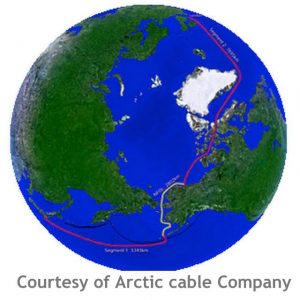Planned Undersea Fiber-Optic Cable Projects in Arctic as Allegory for Changing Region

With all that’s going on in the High North these days, it’s easy to get fixated on one issue or another as the defining concern for the region: militarization, climate change, shipping routes, the list goes on. Sometimes, however, it behooves us to take a step back and clarify the basic issues at stake – particularly for the sake of the average person, who, unlike some of us, has not yet re-drawn his or her mental map of the globe to include the North Pole at center.
It’s often the seemingly benign, overlooked news stories that most effectively illuminate the multifaceted and complex nature of a changing Arctic. I submit to you here one such example. In the past few years, at least three companies have outlined plans for projects to lay undersea fiber-optic cables through the Arctic:
Canadian company Arctic Fibre, Inc. plans to start construction in 2013 on a $640 million Canadian dollar project to lay 15,600km fiber-optic cable from London to Tokyo via the Southern part of the Northwest Passage.
Russian firm Polarnet, which plans to build the Russian Optical Trans-Arctic Submarine Cable System, will be the first to begin work on laying fiber-optic cables starting this August. The cables will span approximately 14,700km through the Northern Sea Route, connecting London to Japan, with various connection branches including to Murmansk and Beijing. TeleGeography reports the communications cables will be worth nearly two billion U.S. dollars.
A third project, the Arctic Link, proposed by Alaskan-based Arctic Cable Company, was announced in January 2010 but has faced numerous hurdles, including a $1.2 billion U.S. dollar price tag. The 15,840km Arctic Link is also slated to connect Japan to London, although it will do so through the Northern portion of the Northwest Passage, and have a greater focus on connectivity in rural communities in Alaska rather than Canada. Construction will supposedly begin in 2014. I would argue that these fiber-optic cable projects are not only the concrete embodiment of a rapidly changing region, but also serve as a very useful metaphor through which one can understand the broader changes happening in the Arctic, and the implications of those changes.
First, the trend of reduced sea ice in the Arctic Ocean in recent years is what prompted the cable project proposals. Previously impracticable because of the characteristics of the frozen Arctic Ocean, ice conditions between the months of August and October are expected to be favorable for laying cables going forward. This exemplifies the fundamental driving factor of increased activity in the Arctic, be it shipping, tourism, military, resource development, or some other type. Changes in the Arctic environment, namely reduced ice, have expanded accessibility and thus possibility in a region that was once largely inhospitable.
In terms of communication lines, the Arctic Ocean floor is an ideal location for cables because the waters aren’t as heavily trafficked as those in warmer climates, and therefore the chances of being hit by a dropping anchor or being damaged by a fishing trawler are greatly diminished. More generally, the more accessible Arctic is enticing to commercial entities precisely because its space and resources have remained largely underutilized until now. It is, in the minds of many, a fresh slate on which to draw, not yet crowded by development and competition.
Ironically, the unique circumstances in the Arctic that attract companies interested in commercial pursuits also present many operating challenges. To lay the new fiber-optic cables, icebreakers will be needed and polar-class ships will have to be specially outfitted – effective transport through icy waters being a key capacity that will necessarily need to expand with increased activity in the future. Just as it is with all commercial pursuits in the Arctic, anticipated costs for the fiber-optic cable projects are significantly higher than for similar work in other regions of the world. In addition, environmental conditions still remain risky: fiber-optic cables will have to be placed up to 600 meters below the surface in some places to avoid icebergs that penetrate beneath the ocean floor. Not to mention, the relative lack of activity that makes the region attractive as a quiet arena in which to operate may no longer be the reality in the near future.
There is also the hot button issue of environmental impact. While proponents of the fiber-optic cables describe the projects as environmentally benign, there is bound to be disagreement from groups who believe the Arctic should be off limits to commercial activity in order to protect the fragile environment from further damage. Just as with all other planned activities in the Arctic, the cable projects will have to obtain approval from various governmental impact review boards. This process has itself become somewhat controversial, however, with the definition of acceptable environmental impact and appropriate mitigation plans still widely debated.
The extension of a fiber-optic network through the Arctic will significantly enhance global connectivity, which holds particular import for the high-speed data exchange that global business and financial markets now rely on. Not only does a changing Arctic region mean enhanced virtual connectivity, but it may also mean increased physical connectivity, should the Northwest Passage and Northern Sea Route develop into the viable shipping lanes that many predict could transform global trade routes. Furthermore, a changing Arctic may mean more for financial markets and businesses than merely faster communications. It is possible that the economic opportunities the region presents could drive investors and companies to take advantage of this new market and integrate it more thoroughly into the global economy.
The fiber-optic cable networks will also improve connectivity for communities in the Far North. Unprecedented change in local communities is a hallmark of the changing Arctic, ever-increased connection to the “Southern” world bringing both opportunities and challenges. On the one hand the modernization of communications in remote Northern communities as a byproduct of the internationally focused cable networks can be seen as a positive force – local communities should rightly benefit from activity that takes place in and near their homeland. However, there is the great challenge of determining what the concept of “benefit” entails, and whether or not the “benefits” from certain commercial activities outweigh what is gained, or simply maintained, by rejecting them.
Finally, the fiber-optic cable projects predictably connect to the vital issues of sovereignty and cooperation in the Arctic. The president of Arctic Fibre, Doug Cunningham, has publicly stated that the Canadian government is pushing along the project because enhanced communications capacity at their Department of National Defense in Cambridge Bay, Nunavut as well as the Canadian High Arctic Research Station translates into stronger Canadian sovereignty in the North. At the same time, the inevitable cross-border nature of the fiber-optic cables drive home the paramount theme in the changing Arctic region: interconnection.
